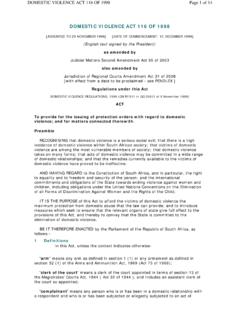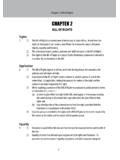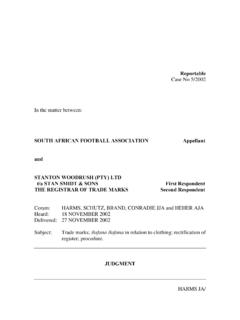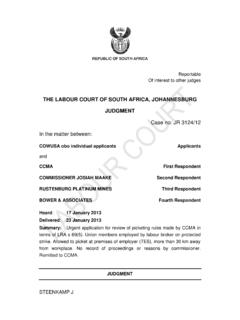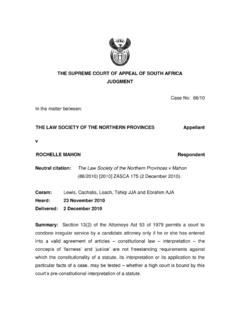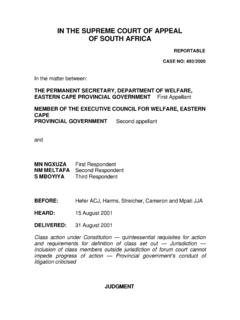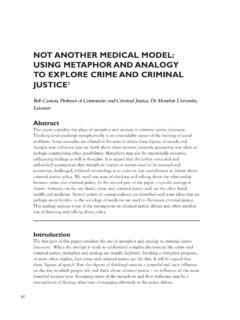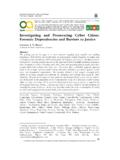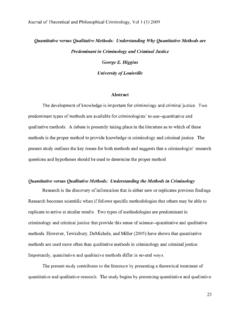Transcription of The Role of ADR Processes in the Criminal Justice …
1 The Role of ADR Processes in the Criminal Justice system : A view from Australia By Melissa Lewis* and Les McCrimmon**. At ALRAESA Conference 4-8 September, 2005. At Imperial Resort Beach Hotel, Entebbe, Uganda. I. Introduction The use of non-traditional dispute resolution Processes , falling within the rubric of Alternative Dispute Resolution (ADR), is now widely accepted in a variety of dispute contexts. In recent years, similar Processes have been adapted and applied in a Criminal Justice context as part of an overall package of Criminal Justice reforms. Across Australian and international jurisdictions, there have been developed a range of alternative' methods for dealing with Criminal offenders, including programs such as victim-offender mediation, family group conferencing, and circle sentencing.
2 A. number of these programs have been applied in Australian jurisdictions, and conferencing in particular has been embraced as a method of dealing with young offenders. The debate as to whether such Processes can or should be applied in a Criminal Justice context raises normative questions as to the role of the Justice system , sociological questions as to the nature of Criminal offending and the relationship between the individual, the community and the state, and descriptive questions as to the adequacy of particular Justice practices. Such analyses must also involve an understanding of the limits of the law in context in other words, political and economic considerations must be taken into account.
3 The Australian Law Reform Commission (ALRC) is currently looking into some aspects of ADR in the Criminal Justice system in the context of its review of the sentencing of federal The Discussion Paper and final Report have yet to be released, however issues relating to deferred sentencing orders, the power to impose conditions when discharging an offender, the role of the victim in sentencing and a range of properly funded alternative sentencing options for Indigenous offenders are being considered. Further, the ALRC is aware of the work of African law reform bodies which have addressed aspects of the feasibility of ADR in the Criminal Justice This paper will provide an overview of the concept of ADR in a Criminal context, with a focus on conferencing programs in Australian jurisdictions.
4 Although it is just one of several innovations in Criminal Justice in Australia, it provides an excellent forum in which to analyse the application of ADR Processes in the Criminal Justice system . II. The Evolution of ADR. Throughout the 1970s and 1980s, a range of dispute resolution Processes such as mediation, conciliation, and arbitration, all of which fall within the umbrella of ADR, gained popularity as an alternative to traditional litigation. The use of ADR in a variety of dispute contexts has grown rapidly in recent years, and has been institutionalised to a large extent through the introduction of * Legal Officer, Australian Law Reform Commission.
5 ** Commissioner, Australian Law Reform Commission. 1. See Australian Law Reform Commission, Sentencing of Federal Offenders, IP 29, (January 2005), available on-line at 2. For example, see South African Law Commission's, Report on Juvenile Justice (Project 106; July 2000); Report on Sentencing (Project 82;. December 2000); and Alternative Dispute Resolution (Issues Paper 8; Project 94; 1997; Nigerian Law Reform Commission's current project on bail and sentencing laws; Lesotho Law Reform Commission's, The Child Law Reform Project (2004); Republic of Ghana Law Reform Commission's current project restorative Justice and alternatives to custodial sentencing.)
6 1. legislative schemes and through the development of professional bodies which have fostered the use of ADR It has been noted by commentators that ADR Processes are not new' but rather have been rediscovered, as informal Justice mechanisms have long been the dominant method of dispute resolution in many societies, and in Indigenous communities in The rebirth' of ADR. is often associated with the development of community Justice centres to resolve neighbourhood disputes in the 1970s and 1980s. Subsequently, the use of ADR Processes spread into other areas, such as family, environmental, commercial and industrial The term ADR movement' is in a sense misleading as it suggests a unity of agenda amongst ADR.
7 Proponents. On the contrary, support for the development and implementation of ADR came from a variety of groups with differing agendas. Astor and Chinkin note that ADR enthusiasts were sometimes strange bedfellows, coming from within the legal system and from its critics, from government agencies and from opponents of bureaucracy who supported community empowerment.'6 Part of the support for the use of ADR Processes sprang from a radical critique of the traditional Western Justice paradigm. Formal court Processes were criticised as being expensive, inaccessible, conflict-inducing, and disempowering for those involved.
8 On the other hand, ADR. was seen as a more accessible, flexible and efficient form of Justice which allowed for the active participation of all parties and assisted in the preservation of However, not all proponents of ADR were critical of formal Justice Processes . Some simply saw ADR as a cheaper more effective way of dealing with more minor disputes that did not warrant the use of court resources. It as been noted that ADR has now become so widely accepted, and even institutionalised and promoted by governments, that what was born of resistance and opposition to the formal Justice system has been extensively integrated and co-opted into the system '.
9 8. What is ADR? Despite the fact that ADR Processes are now regarded as mainstream, there is not consensus as to what the acronym ADR' signifies, nor as to what In Australia, the National Alternative Dispute Resolution Advisory Committee (NADRAC) has defined ADR' broadly as Processes , other than judicial determination, in which an impartial person (an ADR practitioner). assists those in a dispute to resolve the issues between them.'10 The breadth of this definition or description constitutes a recognition of the fact that ADR' is an umbrella term for a variety of Processes which differ in form and application.
10 Differentials include: levels of formality, the presence of lawyers and other parties, the role of the third party (for example, the mediator) and the legal status of any agreement reached. 3. Australian Law Reform Commission, Review of the Adversarial system of Litigation: ADR Its Role in Federal Dispute Resolution, IP 25. (1998), [ ] [ ]. 4. H Astor and C Chinkin, Dispute Resolution in Australia (2nd ed, 2002), 5. 5. Ibid, 6. 6. Ibid, 3. 7. L Boulle, Mediation: Principles, Process, Practice (1996), 35. 8. H Astor and C Chinkin, Dispute Resolution in Australia (2nd ed, 2002), 8. 9.


